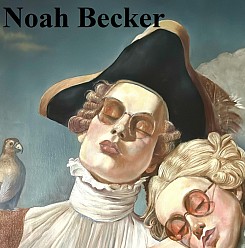Whitehot Magazine
December 2025
"The Best Art In The World"
"The Best Art In The World"
December 2025
May 2009, Interview with Angus Hood

WH: What was your previous body of work like, before this exhibition of paintings at Heskin Contemporary?
AH: It could be described as installation, often site-specific , composed of many small paintings (usually monochromes) , photographed fragmented imagery (a mixture of "original," sometimes re-photographed/"degraded", images - and - re-photographed images/details appropriated from various sources including art, fashion journals, assorted postcards amongst others) and also sculptural elements, relief and free-standing, made of wood, foam packing and various "found" materials. Sometimes it is simply a case of placing two apparently unrelated elements together, sometimes hundreds - but the end result, although seductively coherent, always suggests many readings, no simple answer, a sense of potential yet to be realised.
WH: Though abstract, the paintings all have figuratively provocative titles such as Dark Swirl, Madame X. Why?
AH: I'd argue that the paintings are not abstract - They are an attempt at depiction of a thought process. The works are made in a systematic labor-intensive (objectively as possible !) way , and yet they have a mysterious enigmatic sensitive quality more than the sum of their parts. I felt that there should be titles that accentuate or at least reflect that. However, even the titles or parts of titles which prosaically describe a visual aspect of a work, "Purple Dot", "Dark Swirl, Madam X", "Neckpiece.Delphic Intermission" and so on, in this context appear to add a layer rather than elucidate. A feeling that there is something more to "get" but it's somehow just out of reach. (Also , when thinking about whether to title or untitle, in the case of "Dark Swirl, Madam X" for instance, I was looking at a book on Medardo Rosso - late 19th/early 20th C Italian sculptor. One of his works had been given the title "Madam X" by scholars/curators cataloging his work after his death. Of course this adds a layer of intrigue to the work perhaps beyond the original intention.) "Be my...." seems like a fragment of conversation overheard or remembered which of course could be a reference to "Be My Baby" by The Ronettes - perhaps the vibrant color resonating from the centre of that painting represents the rush of excitement that can enduce - but it's not complete therefore the only certainty is the work and the viewer's experience of it.
WH: Your choice of colors can be termed perhaps delicate. This fits perfectly with the forms you have repeated throughout the series of paintings. How did you come upon this shape and how did you choose the colors that went along with each painting in the series?
AH: A finely tuned sense of color. I wanted this series of works to have an elegant, feminine, discreetly subversive quality. Infact I'd say that goes for all of my work. Having said that - the color (and texture) is chosen in a fairly systematic way so that a balance is achieved. Sometimes the color combination is an approximation of something experienced outwith the studio, sometimes it is suggested by the previous painting. The shape evolved from a combination of different sources - photos , drawings cut-out and collaged - but later I became interested in the void/negative left by the cut-out and made drawings to be cut with the intention of leaving a central void . The shape is open to so many different inerpretations - That's what I like about it. It's consistent.
WH: Can you describe the process of creating these works? Do you start with the background of paint, or with the cut-outs? What tools do you use in creating these works?
AH: I prepare a selection of background and foreground using a brush and acrylic paint. The paper "foreground" is then drawn on, cut out with a sharp knife a background is selected and fixed to the "background" with an acrylic medium.
WH: In terms of your entire ouvre, how would you describe what you do as an artist? What are your concerns in your practice and how do they manifest themselves in your work and choice of medium?
AH: The work is an engagement in the complex nature of experience.
WH: Would you say that your country, Scotland, has influenced your work? What other influences have you had that have brought your work to where it is and you to where you are in your artistic/career development?
AH: In so many ways - people , light , color , climate , outward looking socio-political historic context , geographic location on the edge of Europe , hard working do it your self culture . My parents . A long term relationship with New York City ! Art ! Nature ! My muse !
WH: Do you pay much attention to what your contemporaries in the art world are producing? If so, who do you like?
AH: I pay a little bit of attention to a lot of what is going on. I've heard this increasingly widespread condition described as "constant partial attention". (in other words too many to mention and a fear of leaving someone out)
WH: If you had to pick some other thing in life to be or do, what would it be?
AH: I wouldn't.

Nicollette Ramirez
Nicollette Ramirez is an art dealer, writer, producer and events organizer, nurturing artists and promoting their work. Nicollette’s projects have often combined artists from diverse backgrounds working in different media in various locations. Nicollette named her company Beez And Honey.
view all articles from this author











